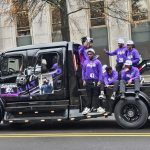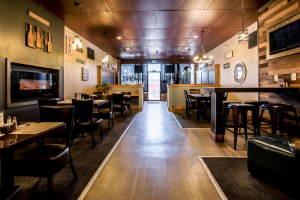Woolly Mammoth Theatre and Second City collaboration pokes fun at African American life
By D. Kevin McNeir
Special to the AFRO
Whether you’re curled up on the couch watching your favorite sitcom like “The Jeffersons,” or chuckling at the latest installment of “Boondocks,” when it comes to relieving stress, laughter is just what the doctor ordered.

At least that’s what an article published by the Mayo Clinic (www.mayoclinic.org) suggests, noting laughter not only lightens one’s mental concerns and induces positive physical changes in the body but also alleviates pain and makes it easier to cope with difficult situations.
As Dick Gregory – the triple threat comedian, author and activist – often said, “They were going to laugh anyway, but if I made the jokes, they’d laugh with me instead of at me.”
Throughout his career, Gregory, determined to point out the reality of sensitive and often painful issues like racism, routinely employed humor when addressing the extent of racial discrimination in America. And like Gregory, the sketch comedy now on stage at D.C.’s Woolly Mammoth Theatre (WMT) in collaboration with Chicago’s The Second City, “Dance Like There’s Black People Watching” invites the audience – Blacks in particular – to reflect on scenes, situations and circumstances commonplace to African Americans, performed in hopes of temporarily relieving the stress.
“Woolly is committed to staging cutting-edge work that challenges us to think critically about the world around us and laughter is one of the most powerful ways to engage and inspire an audience,” Maria Manuela Goyanes, WMT artistic director, said in a statement.
The show was created specifically for Woolly Mammoth and Washington, D.C., and represents the latest in nearly two decades of collaboration between Woolly Mammoth and the Chicago-based Second City – touted as the world’s premier comedy club, theater and school of improvisation.
Blacks invited to laugh – perhaps to keep from crying
Ron Wilson, director and Second City associate artistic director, said the title of the show provides a clue to the mood of the production.
“With the songs, sketches and improvisation that occurs on stage each night, it’s a lot like ‘In Living Color’ or ‘Saturday Night Live,’ but in this context we can and do whatever we want,” Wilson said. “We are on our P’s and Q’s as we address what Blacks in America are talking about today – those things that are important to us.
“Improv by nature is organic and this show is no exception. The cast is composed of six of the funniest comedians with whom I have ever worked who deliver inside jokes that Blacks would understand and would tend to share with our friends and families. But the stuff they do since the show was conceived and developed several years ago strikes the heart and constantly evokes laughter,” Wilson said.
Max Thomas, a member of the ensemble and a multi-disciplinary artist, born and raised on the south side of Chicago, joined Second City when he was just 14 years old as part of its teen ensemble. He said with Vice President Kamala Harris losing in her recent bid for the White House, Blacks wanted and needed a show like this.
“For years, the electoral process has all but excluded African Americans, and when Kamala Harris became the presidential candidate many of us were hopeful,” Thomas said.

(RIGHT) Six talented comedians, Breon Arzell (left, front), Tamieka Chavis, Max Thomas, Arlietta Hall, Julius Shanks II (left, rear) and Jillian Ebanks, comprise the ensemble for the satiric comedy “Dance Like There’s Black People Watching,” a collaborative work with Chicago’s The Second City and Woolly Mammoth Theatre, on stage at the Woolly Mammoth in Washington, D.C., through Dec. 22. (Photo courtesy Teresa Castracane)
“This show, we believe, will help people celebrate the vice president’s efforts and experience Black joy. It’s providing a space where Blacks can unite, if only for one evening of laughter. Ever since I was a child, I’ve had a flair for comedy and for as long as I can remember, my goal was to become a professional comedian – it’s always been my gift,” said Thomas, who added that he first began to perform standup comedy when he was 9.
“As for this show, it represents material that I and a group of other comedians have been working on for about 10 years. The D.C. production is the third installment of the show which has been featured exclusively at Second City as a post-pandemic project for the past two years,” he said.
Audience members reflect on Woolly Mammoth’s special ‘Blackout’ performance
During a recent performance of “Dance Like There’s Black People Watching,” Woolly Mammoth continued a tradition first established in September 2022 during the run of the hilarious satiric comedy, “Ain’t No Mo,” which featured actor Jon Hudson Odom as a no-nonsense drag queen named Peaches.
As Odom took center stage, he told the audience, “This is your church; think of this as your Black church” – an invitation that would mark Woolly’s first “Blackout” performance.
And on Nov. 9, fans were treated to another Blackout performance during which Woolly invited an all-Black identifying audience to enjoy the show – one which also features an all-Black cast. Some members of the audience remained after the performance for a talkback with the cast.
Usha Parker, a native of the Virgin Islands now living in Cheverly, Maryland, said the content of the show was timely as Blacks attempt to make sense of the recent election cycle.
“I brought both of my daughters to the show, and the oldest, who’s a junior at Duke Ellington School of the Arts (Washington, D.C.), cried when she heard that Harris had lost, afraid of her Blackness and what the future may hold for people of color,” Parker said.
The show was a soft and familiar place to land amid that uncertainty, she continued.
“Some of the stereotypes and topics that were presented in the show were too nuanced and mature for my girls who are 16 and 13, but it was still comforting to be among an all-Black audience, so I had to explain a few things to them,” the 47-year-old said. “It’s interesting how times change in just one generation. For example, the skit featuring two friends who panic when they realize that the streetlights are coming on soon didn’t make sense to my girls. They don’t play outside anymore like we did. Still, it was our story told by people who look like us.”
Native Washingtonian Christopher McLaughlin, 48, who lives in Southeast D.C., said the references to Black life in the District were “spot on.”
“So much of what I saw represented my lived experience in D.C. It was like they were examining parts of my life – the good and the bad things I’ve witnessed and endured as a Black man,” he said.
“The most compelling skit was when they addressed the inhumane treatment Blacks faced during slavery and how its legacy continues today,” McLaughlin continued. “The cast pulled a White man from the audience who was one of only a handful of Whites at the performance and switched the roles so that Whites became property and Blacks became the slave owners. That was powerful and if only for a few minutes, he got a taste of what we have endured for centuries.”
For Arnija Stegall, 21, also from Southeast D.C., the concept of the Blackout performance was both intriguing and invigorating.
“I am interested in the theater business and am currently working in scene design and painting, but tickets are too expensive, so I haven’t seen many shows. Fortunately, this one was made affordable,” Stegall said. “Some of the skits I didn’t totally understand because of my age but after thinking about them, the hidden messages became clearer.
“The skit with the therapist and patient resonated with me because while many Blacks would benefit from therapy, we still have this notion that it’s only something for Whites. Overall, it was like watching Aaron Mc Gruder’s ‘Boondocks’ comic strip brought to life on stage. To really enjoy the show, or even his comic strip, you must participate. I know I did,” she said.
Ricky Jefferson, 65, another D.C. native now living in Alexandria, Virginia, attended the show after receiving an invitation from his cousin.
“I laughed and laughed – I just cracked up for the entire show,” Jefferson said. “One of the cast members, Arlietta Hall was particularly impressive. And the play on Charles Dickens’ ghosts of Christmas past, present and future to the ‘ghosts of past, present and future was extremely creative and eye-opening. If White Americans could walk in our shoes, or our ancestors’ shoes for one day, maybe they’d understand, maybe America would be a better place for us all,” Jefferson said.
“Dance Like There’s Black People Watching” continues through Dec. 22. For tickets or more information, visit www.woollymammoth.net.
The post Healing effects of laughter showcased in ‘Dance Like There’s Black People Watching’ appeared first on AFRO American Newspapers.











